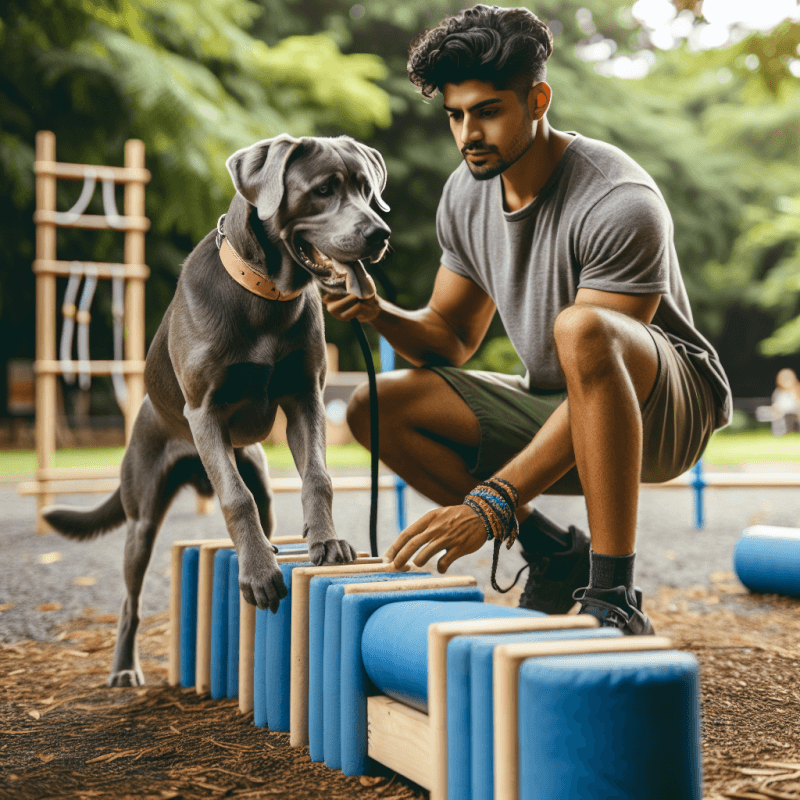Are you struggling with your dog’s behavior? Look no further than Blue Dog Training And Behavior. With their extensive knowledge and expertise, they are dedicated to providing you and your furry friend with the tools and techniques needed to address any behavioral issues. Whether it’s leash pulling, separation anxiety, or aggressive behaviors, Blue Dog Training And Behavior has got you covered. By understanding the unique needs of each dog and tailoring their methods accordingly, they ensure a personalized and effective approach to training. Say goodbye to frustration and hello to a well-behaved and happy dog with Blue Dog Training And Behavior.
Understanding Blue Dog Training
Understanding the Blue Dog Phenomenon
Blue Dog behavior refers to a specific set of traits and characteristics that are commonly observed in certain canines. The term “Blue Dog” is often used to describe dogs that exhibit signs of anxiety, fear, or aggression. These behaviors can be challenging for both the dog and their owner, leading to difficulties in training and forming a strong bond. Understanding the blue dog phenomenon is crucial to effectively address and manage these behaviors.
Ready for Cat Trivia?
Test your knowledge about cats!

Causes of Blue Dog Behavior
Blue Dog behavior can have various causes, including genetics, early experiences, and environmental factors. Some dogs may be predisposed to anxiety or fear-based behaviors due to genetic factors, while others may develop these behaviors as a result of traumatic experiences such as abuse or neglect. Additionally, factors like inadequate socialization, separation anxiety, or a lack of mental stimulation can also contribute to blue dog behavior.
Recognizing Blue Dog Behavior
Recognizing blue dog behavior is essential for early intervention and effective training. Some common signs of blue dog behavior include excessive barking, hiding, trembling, pacing, destructive behavior, and aggression towards people or other animals. It is crucial to distinguish between normal canine behavior and blue dog behavior to address these issues appropriately.
The Importance of Blue Dog Training
Blue dog training is crucial for the well-being of both the dog and their owner. By addressing and managing blue dog behavior, owners can provide their dogs with a happy and healthy life while ensuring the safety of those around them. Training helps blue dogs develop confidence, reduce anxiety, and learn appropriate behaviors, leading to enhanced communication and a stronger bond between the dog and their owner.
Benefits of Blue Dog Training
Improving Canine Behavior
One of the significant benefits of blue dog training is its ability to improve canine behavior. Through positive reinforcement training techniques, blue dogs can learn new behaviors and overcome fear or anxiety-based behaviors. Training helps them become more obedient, responsive, and adaptable, enhancing their overall well-being and happiness.
Reducing Aggression in Blue Dogs
Aggression is a common problem in blue dogs, and effective training can play a vital role in reducing aggressive behaviors. By understanding the underlying triggers for aggression and implementing appropriate training techniques, owners can help their blue dogs overcome aggression and develop better coping mechanisms. This not only improves the dog’s quality of life but also ensures the safety of those around them.
Enhancing Communication and Bonding
Blue dog training provides an opportunity for owners to effectively communicate with their dogs and build a strong bond based on trust and mutual understanding. By using positive reinforcement techniques, owners can establish clear communication channels, leading to improved obedience and cooperation. This bond enhances the overall relationship and strengthens the emotional connection between the dog and their owner.
Ensuring a Happy and Healthy Blue Dog
Training is essential for the mental and physical well-being of blue dogs. By providing regular mental stimulation through training sessions, owners can prevent boredom and destructive behaviors. Additionally, training helps blue dogs build confidence, reduce anxiety, and provide structure and routine in their daily lives, ultimately leading to a happier and healthier canine companion.

Effective Techniques for Training Blue Dogs
Positive Reinforcement Training
Positive reinforcement training is a highly effective technique for training blue dogs. This training method involves rewarding desired behaviors with treats, praise, or play, reinforcing the association between the behavior and the reward. By focusing on positive reinforcement, blue dogs can develop new skills, overcome fear or anxiety, and develop a positive outlook towards training sessions.
Socialization for Blue Dogs
Socialization plays a crucial role in training blue dogs. By gradually exposing them to various environments, people, and other animals, owners can help their blue dogs become more confident and comfortable in different social situations. Socialization is especially important during the critical period of puppyhood but can also be beneficial for adult blue dogs to overcome fear or anxiety-related behaviors.
Redirecting Blue Dog Behavior
Redirecting blue dog behavior involves providing alternative outlets for their energy or frustration. For example, if a blue dog demonstrates destructive chewing behavior, redirecting their attention by providing appropriate chew toys can divert their focus and prevent further damage. This technique helps to address undesirable behavior and encourages the development of more appropriate and acceptable behaviors.
Crate Training for Blue Dogs
Crate training is a useful technique for blue dogs as it provides them with a safe and secure space of their own. Using positive reinforcement, owners can gradually introduce blue dogs to their crates and teach them to associate it with positive experiences. Crate training can help reduce anxiety, facilitate house training, and provide a comfortable space for blue dogs to relax and unwind.
Professional Blue Dog Training Programs
Choosing a Qualified Blue Dog Trainer
When seeking professional help for blue dog training, it is essential to choose a qualified and experienced trainer. Look for trainers who have certifications, relevant experience, and a positive training philosophy. A qualified blue dog trainer will have the knowledge and expertise to understand and address the specific needs of blue dogs effectively.
Types of Blue Dog Training Programs
There are various types of blue dog training programs available, ranging from obedience classes to behavior modification programs. Obedience classes focus on teaching basic commands and improving overall obedience, while behavior modification programs specifically target and address blue dog behaviors such as fear or anxiety. Choosing the right program depends on the individual needs and behaviors of the blue dog.
Evaluation and Customization of Training Methods
A professional blue dog trainer will conduct a thorough evaluation of the dog’s behavior and temperament to design a customized training plan. Each blue dog is unique, and a one-size-fits-all approach may not be effective. By tailoring the training methods and techniques to the specific needs and behaviors of the blue dog, trainers can maximize the training’s effectiveness and ensure long-term success.

Managing Blue Dog Behavior at Home
Establishing Clear Boundaries
Establishing clear boundaries is crucial for managing blue dog behavior at home. Consistent rules and boundaries help blue dogs understand what is expected of them and what behaviors are acceptable. By setting clear boundaries, owners can prevent confusion and ensure a structured environment that promotes positive behavior and discourages undesirable ones.
Creating a Safe Space for Blue Dogs
Creating a safe space for blue dogs is essential for their well-being. This could be a designated area in the house where the dog feels secure, such as a crate or a quiet room. Providing access to this safe space allows the blue dog to retreat and relax when they feel overwhelmed or anxious. It is important to respect their safe space and avoid disturbing them while they are in it.
Using Environmental Enrichment
Environmental enrichment is an effective way to stimulate and engage blue dogs mentally and physically. Providing interactive toys, puzzle feeders, and engaging in activities such as scent work or agility training can prevent boredom and destructive behaviors. Enriching the environment helps keep the blue dog’s mind stimulated, satisfies their natural instincts, and promotes overall well-being.
Soothing Techniques for Blue Dogs
Soothing techniques can help calm and relax blue dogs when they experience anxiety or fear. These techniques can include methods such as massage, aromatherapy, or using calming pheromone diffusers. It is important to observe and understand the individual blue dog’s preferences and responses to different calming techniques to find the most effective ones for them.
Common Challenges in Blue Dog Training
Fear and Anxiety in Blue Dogs
Fear and anxiety are common challenges in blue dog training. These emotions can significantly impact a blue dog’s behavior and learning. It is important to address fear and anxiety through gradual exposure and positive reinforcement techniques. Patience, understanding, and providing a supportive environment are key in helping blue dogs overcome their fears and build confidence.
Underlying Medical Issues
Sometimes, blue dog behavior issues can be related to underlying medical issues. Conditions such as pain, hormonal imbalances, or neurological disorders can manifest as behavioral problems. It is crucial to rule out any underlying medical causes by consulting with a veterinarian before solely attributing the behavior to training or behavioral issues.
Dealing with Reactive Blue Dog Behavior
Reactive behavior, such as lunging or barking at other dogs or people, can be a challenge for blue dog owners. Careful management strategies, along with training techniques aimed at reducing reactivity, can be employed. Professional help from a Certified Canine Behaviorist or a qualified trainer experienced in working with reactive dogs should be sought to effectively address this issue.
Managing Resource Guarding
Resource guarding is a common behavior where dogs become possessive and protective over certain items. With blue dogs, resource guarding can be exacerbated due to anxiety or fear. Training techniques focused on teaching the dog that sharing resources leads to positive outcomes can help manage and reduce resource guarding behavior in blue dogs.

Blue Dogs and Aggression
Understanding Aggressive Blue Dog Behavior
Aggressive blue dog behavior includes behaviors such as growling, biting, or lunging towards people or other animals. It is crucial to understand that aggression is often a symptom of an underlying issue, such as fear, anxiety, or a lack of socialization. Identifying the root cause of the aggression is essential for effective training and behavior modification.
Types of Aggression in Blue Dogs
There are various types of aggression in blue dogs, including fear-based aggression, territorial aggression, and predatory aggression. Each type may require a different approach for successful training and behavior modification. It is essential to work with a qualified professional to accurately identify the type of aggression and develop an appropriate training plan.
Preventing Aggression through Early Training
Early training and socialization are essential for preventing aggression in blue dogs. Starting training and socialization during the critical period of puppyhood can help lay a solid foundation for positive behavior and reduce the risk of aggression later in life. Prioritizing early training and socialization can significantly contribute to the overall well-being and temperament of blue dogs.
Working with Aggression Triggers
Identifying and managing aggression triggers is crucial in training blue dogs. These triggers can be specific situations, people, or objects that provoke aggressive responses in the dog. By gradually exposing the blue dog to these triggers under controlled conditions and using positive reinforcement techniques, the dog can learn to associate the triggers with positive experiences, ultimately reducing aggression.
Blue Dog Training Tools and Equipment
Choosing Appropriate Training Collars
When selecting training collars for blue dogs, it is important to choose ones that are safe, effective, and humane. Collars like flat buckle collars or front-clip harnesses are often suitable for blue dogs, as they provide control without causing discomfort or pain. Avoid tools that rely on aversive techniques such as choke or prong collars, as these can escalate aggression and anxiety in blue dogs.
Leashes and Harnesses for Blue Dogs
Leashes and harnesses are crucial tools for managing blue dog behavior during walks and outings. Using a sturdy leash and a well-fitting harness ensures control and safety while allowing the blue dog to explore and enjoy their surroundings. Opt for harnesses that distribute pressure evenly and provide adequate support without restricting the dog’s movements or causing discomfort.
Interactive Toys for Mental Stimulation
Interactive toys are a great tool for mental stimulation and engagement during training sessions or playtime. These toys engage the blue dog’s mind, encourage problem-solving, and help channel their energy into constructive activities. Puzzle toys, treat-dispensing toys, and interactive fetch toys are some examples that can provide mental stimulation and prevent boredom.
Training Treats and Rewards
Training treats and rewards are essential for positive reinforcement training. Choose treats that are small in size, soft, and highly palatable to entice the blue dog during training sessions. Reinforce desirable behaviors promptly with treats and praise to encourage the dog to repeat those behaviors. Consistency in rewarding and using high-value treats can help accelerate the training process.

Seeking Professional Help for Blue Dog Behavior Issues
When to Consult a Professional
Seeking professional help is recommended when blue dog behavior issues become too challenging to manage independently or when aggression or fear-related behaviors escalate. Professional intervention should also be sought if there are concerns about the safety of the dog, the owner, or others. A certified canine behaviorist or an experienced professional trainer can provide expert guidance and support.
Benefits of Professional Intervention
Professional intervention offers several benefits when dealing with blue dog behavior issues. Professionals have the knowledge and expertise to accurately assess the problem, develop effective training plans tailored to the specific needs of the blue dog, and provide ongoing support and guidance throughout the training process. Their experience and understanding of canine behavior can greatly contribute to a successful outcome.
Finding a Certified Canine Behaviorist
Certified Canine Behaviorists are professionals who specialize in understanding and addressing canine behavior issues. They have undergone extensive education, training, and certification to ensure that they possess the necessary knowledge and skills to work with blue dogs effectively. When seeking professional help, look for individuals who are certified by reputable organizations and have a proven track record of success.
Maintaining a Consistent Training Routine
Importance of Consistency in Blue Dog Training
Consistency is key to successful blue dog training. Dogs thrive when they have a predictable routine and clear expectations. Consistency helps them understand what is expected of them and reinforces their training. By maintaining a consistent training routine, owners can effectively reinforce positive behaviors and prevent the regression of undesirable behaviors.
Establishing Daily Training Sessions
Daily training sessions are essential for blue dog training. Short, focused sessions provide regular mental stimulation and allow for continuous progress. Set aside specific times each day for training, ensuring a calm and distraction-free environment. By making training a part of the daily routine, blue dogs learn to anticipate and actively engage in the training process.
Progress Tracking and Adjustments
Tracking progress is essential in blue dog training to evaluate the effectiveness of training techniques and make necessary adjustments. Keep a record of training sessions, noting the dog’s behavior, responses, and any changes observed. This record allows for a comprehensive assessment of the training progress, identifies areas that require improvement, and helps modify the training plan to better suit the dog’s needs.
By understanding blue dog behavior, implementing effective training techniques, and seeking professional help when needed, owners can create a safe, happy, and well-behaved canine companion. Blue dog training is a journey that requires patience, consistency, and a deep understanding of the unique needs of blue dogs. With the right approach and commitment, blue dogs can overcome their challenges, thrive, and lead fulfilling lives.



